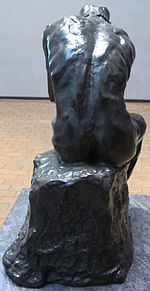The Thinker

Le Penseur in the Musée Rodin in Paris

The Thinker (French: Le Penseur) is a bronze sculpture by Auguste Rodin, usually placed on a stone pedestal. The work shows a nude male figure of over life-size sitting on a rock with his chin resting on one hand as though deep in thought, often used as an image to represent philosophy. There are about 28 full-sized castings, in which the figure is about 186cm high, though not all were made during Rodin's lifetime and under his supervision. There are various other versions, as well, several in plaster, and studies and posthumous castings exist in a range of sizes. Rodin first conceived the figure as part of his work The Gates of Hell commissioned in 1880, but the first of the familiar monumental bronze castings did not appear until 1904.
Contents
1 Origin
2 Casts
3 See also
4 References
5 External links
Origin

The Thinker in The Gates of Hell at the Musée Rodin
The Thinker was initially named The Poet (French: Le Poète), and was part of a large commission begun in 1880 for a doorway surround called The Gates of Hell. Rodin based this on The Divine Comedy of Dante Alighieri, and most of the figures in the work represented the main characters in the poem with The Thinker at the center of the composition over the doorway and about larger than most of the other figures. Some critics believe that it was originally intended to depict Dante at the gates of Hell, pondering his great poem. Other critics reject that theory, pointing out that the figure is naked while Dante is fully clothed throughout his poem, and that the sculpture's physique does not correspond to Dante's effete figure.[1] The sculpture is nude, as Rodin wanted a heroic figure in the tradition of Michelangelo, to represent intellect as well as poetry.[citation needed]
This detail from the Gates of Hell was first named The Thinker by foundry workers, who noted its similarity to Michelangelo's statue of Lorenzo de Medici called Il Penseroso (The Thinker),[2] and Rodin decided to treat the figure as an independent work at a larger size. The figure was designed to be seen from below and is normally displayed on a fairly high plinth, although the heights vary considerably chosen by the various owners.

Rear view, Tokyo
Casts

Signature of A. Rodin on a cast at Columbia University, NYC
The Thinker has been cast in multiple versions and is found around the world, but the history is complicated of the progression from models to castings and is still not entirely clear. About 28 monumental-sized bronze casts are in museums and public places. In addition, there are sculptures of different study-sized scales and plaster versions (often painted bronze) in both monumental and study sizes. Some newer castings have been produced posthumously and are not considered part of the original production.
Rodin made the first small plaster version around 1880. The first large-scale bronze casting was finished in 1902 but not presented to the public until 1904.[dubious ] It became the property of the city of Paris thanks to a subscription organized by Rodin admirers, and was put in front of the Panthéon in 1906. In 1922, it was moved to the Hôtel Biron, which had been transformed into the Rodin Museum.
The first cast sculpture can be found in front of Grawemeyer Hall on the University of Louisville Belknap Campus in Louisville, Kentucky. It was made in Paris and was first displayed at the St. Louis World's Fair in 1904, then given to the city. This sculpture was the only cast created by the lost-wax casting method.[3][citation needed]
See also
- List of public art in San Francisco
References
^ Elsen, Albert L., Rodin's Gates of Hell, University of Minnesota Press, Minneapolis Minnesota, 1960 p. 96.
^ Elsen, Albert L., Rodin's Gates of Hell, University of Minnesota Press, Minneapolis Minnesota, 1960 p. 77.
^ "U of L Belknap Campus Tour, page 2". University of Louisville. 2000. Archived from the original on February 26, 2011. Retrieved 15 November 2010..mw-parser-output cite.citation{font-style:inherit}.mw-parser-output q{quotes:"""""""'""'"}.mw-parser-output code.cs1-code{color:inherit;background:inherit;border:inherit;padding:inherit}.mw-parser-output .cs1-lock-free a{background:url("//upload.wikimedia.org/wikipedia/commons/thumb/6/65/Lock-green.svg/9px-Lock-green.svg.png")no-repeat;background-position:right .1em center}.mw-parser-output .cs1-lock-limited a,.mw-parser-output .cs1-lock-registration a{background:url("//upload.wikimedia.org/wikipedia/commons/thumb/d/d6/Lock-gray-alt-2.svg/9px-Lock-gray-alt-2.svg.png")no-repeat;background-position:right .1em center}.mw-parser-output .cs1-lock-subscription a{background:url("//upload.wikimedia.org/wikipedia/commons/thumb/a/aa/Lock-red-alt-2.svg/9px-Lock-red-alt-2.svg.png")no-repeat;background-position:right .1em center}.mw-parser-output .cs1-subscription,.mw-parser-output .cs1-registration{color:#555}.mw-parser-output .cs1-subscription span,.mw-parser-output .cs1-registration span{border-bottom:1px dotted;cursor:help}.mw-parser-output .cs1-hidden-error{display:none;font-size:100%}.mw-parser-output .cs1-visible-error{font-size:100%}.mw-parser-output .cs1-subscription,.mw-parser-output .cs1-registration,.mw-parser-output .cs1-format{font-size:95%}.mw-parser-output .cs1-kern-left,.mw-parser-output .cs1-kern-wl-left{padding-left:0.2em}.mw-parser-output .cs1-kern-right,.mw-parser-output .cs1-kern-wl-right{padding-right:0.2em}
External links
| Wikimedia Commons has media related to Le Penseur. |
Rodin: The B. Gerald Cantor Collection, a full text exhibition catalog from The Metropolitan Museum of Art, which contains material on The Thinker
The "Penseur", a poem by Philadelphia poet Florence Earle Coates.
Link to The Thinker at the official Web site of the Musée Rodin.
The Thinker Inspiration, Analysis and Critical Reception
The Thinker project, Munich. Discussion of the history of the many casts of this artwork.
The Thinker, Iris & B. Gerald Cantor Center for Visual Arts at Stanford University, Object Number 1988.106, bronze cast No.
Auguste Rodin and The Thinker, The story behind his most iconic sculpture of all-time at biography.com.
10, edition of 12.